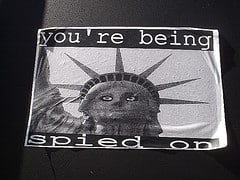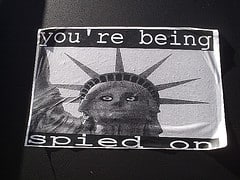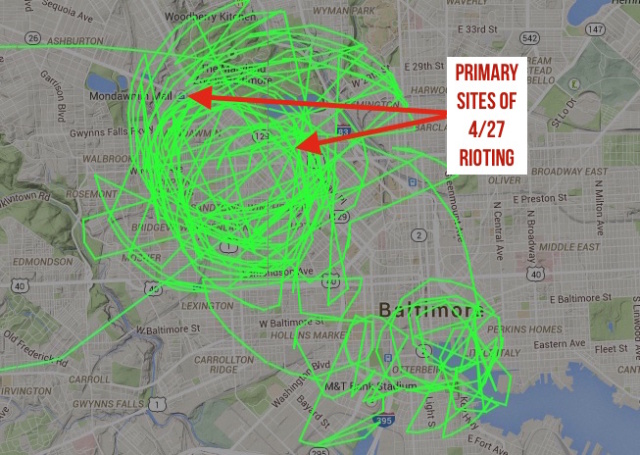The FBI surveilled peaceful protests in Baltimore following the police killing of Freddie Gray, protest acts protected by the First Amendment, from the air, using high-tech monitoring aircraft.
The surveillance aircraft can be equipped with infrared and other surveillance gear that extend the intrusion into privacy far into unconstitutional territory.
When violence rocked Baltimore recently, local Police Captain Jeff Long told reporters “When you’ve got something like this, you’ve got people running all over the place, throwing rocks and looting and starting vehicles on fire and destroying vehicles like this, really the best vantage point you can get is from the air.”
Which is why city and state police took to the air in helicopters and small planes, all clearly marked.
Eyes in the Skies
Less obvious was a single engine prop Cessna and a small Cessna jet flying over the city, not during the worst of the violence, but during periods of peaceful protest. Who did they belong to?
In response to media inquiries, the Baltimore police referred questions to the FBI. The FBI initially refused to comment. They eventually released a statement claiming the aircraft worked for the Bureau, saying also “The aircraft were specifically used to assist in providing high altitude observation of potential criminal activity to enable rapid response by police officers on the ground. The FBI aircraft were not there to monitor lawfully protected first amendment activity.” The local FBI spokesperson also noted any aviation support supplied to local police must be approved at the highest levels of the FBI.
The aircraft, however, are not owned, overtly at least, by the FBI. Research done in part by the Washington Post shows the ostensible owners as NG Research, located near Manassas Regional Airport, just outside of Washington, DC. Searches of public records revealed little about the company, which could not be reached by the Post.
Understanding the Technology
The key to understanding the constitutionality of the FBI’s dragnet search is knowing what sensors were mounted on each aircraft.
According to Cessna, “when you choose Citation [the jet believed to have been overhead in Baltimore] for your surveillance and patrol aircraft, we customize your jet to fit your exact mission requirements. For example, jets can be equipped with a securely mounted EO/IR device, technology specially suited to carry out territory surveillance work such as border patrol, land-use patrol, and general policing.”
EO/IR refers to electro-optical and infrared capabilities. In this context the former can be any type of laser or telescopic device used for visible light, the latter measuring “heat,” allowing one to “see” in the dark. Stingrays, electronic devices which can monitor and/or disrupt cell phone communications, can also be mounted on such aircraft.
The FBI is also known to employ aircraft with the Wescam stabilized surveillance sensor pod, allowing high quality images to be taken under bumpy flight conditions.
Such technology has been used extensively by the U.S. military in general, and by Special Forces in the particular, in their hunt for terrorists abroad, and represents another example of the weapons of war coming to the Homeland, now aimed at Americans instead of “the enemy.”
Here’s a sample image via Ars Technica of what a zoomed out nighttime IR image can show:
ACLU Actions
The ACLU has filed a request with the FBI to learn what video and cell phone data was collected during the flights.
It is possible that the FBI was simply duplicating the visual search capabilities likely to have been employed by regular Baltimore cops and their prop aircraft. However, such duplication of effort seems unlikely. One can reasonably suppose the FBI joined the aerial surveillance with something new to bring to the party, such as more advanced observation tech.
For example, on May 1 and May 2, what is believed to be the FBI Cessna Citation V jet made nighttime flights (path recorded below), orbiting Baltimore at the relatively low altitudes for a jet aircraft of 6,400 and 9,400 feet, based on records from Flightradar24. That action would be consistent with the use of any of the surveillance devices noted above.
Constitutional Questions
The constitutional questions are significant.
Civil libertarians have particular concern about surveillance technology that can gather images across dozens of city blocks, tracking the travel, actions and associations of people under no suspicion of criminal activity.
“A lot of these technologies sweep very, very broadly, and, at a minimum, the public should have a right to know what’s going on,” said Jay Stanley, a senior policy analyst at the ACLU specializing in privacy and technology issues.
If the FBI was using infrared (IR) devices overhead, that use may have constituted an unlawful search.
In Kyllo v. United States, 533 U.S. 27 (2001), the Supreme Court held that the use of a thermal imaging, or IR, device from a public vantage point to monitor the radiation of heat from a person’s home was a “search” within the meaning of the Fourth Amendment, and thus required a warrant.
Perhaps the ACLU can check if the FBI was issued warrants for most of the city of Baltimore. And then stick a fork in it people, ’cause this democracy is about done.




